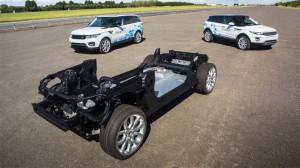When it revealed a trio of battery-based prototypes, collectively known as Concept_e, in September, Jaguar Land Rover appeared ready to join key rivals set to electrify their luxury line-ups.
But talk of plug-in and pure battery-electric SUVs and sedans may be a bit premature, according to JLR Chief Executive Ralf Speth. While “it is clear” the British maker will eventually have to go that route to meet tough new global emissions and mileage mandates, “it will take quite a while,” he told TheDetroitBureau.com during an interview.
“There is only one way you have to go” because of the new rules, said Speth, but JLR is waiting for improved batteries and an expanded charging infrastructure before it makes a serious push into electrification beyond the diesel hybrid Land Rover model it introduced in Europe.
Skeptics have suggested that the carmaker, a subsidiary of India’s Tata Motors, is hesitating for other reasons, primarily the hefty price tag of developing all-new, electrified drivelines. For his part, Speth suggested that “We prioritize. We have a clear focus” on the direction the two luxury brands should take.
That vision includes a significant increase in the number of products both Jaguar and Land Rover will be offering in the coming years. The recent Los Angeles Auto Show saw three of the newest offerings go on display:
- The Range Rover Evoque Convertible, only the second ragtop SUVs ever brought to market;
- The Jaguar XE, the maker’s new entry-luxury sedan, a replacement for the old X-Type; and
- The Jaguar F-Pace, its first-ever sport-utility vehicle.
(“Bond Girl” Naomie Harris helps Land Rover go topless. Click Here for the story.)
Until recently, JLR intended to keep the two sides of its house clearly separated. Land Rover would focus on utility vehicles, Jaguar on sedans, coupes, sports cars and convertibles. But with CUVs and SUVs now outselling sedans in the U.S., JLR’s single-largest market, the lines have become blurred. In fact, Jaguar is expected to bring at least one more ute, the larger J-Pace, to market in the near future.
The Range Rover Evoque Convertible is another segment-bender. To Speth, it is not about generating volume, the ragtop expected to target “only a very small niche, but it will make a statement of what we really want to do.” And that’s to take leadership in the upscale utility-vehicle market.
(JLR launched three new models at LA Auto Show. Click Here to check them all out.)
The Evoque has certainly helped, the smallest model to wear the Range Rover badge becoming the brand’s best-selling model ever.
Land Rover has launched a new three-pillar strategy with products like the latest version of the Discovery. And with all the various new Jaguars, it is clear JLR is chasing German rivals like BMW and Mercedes-Benz who have been proliferating their own lines at a prodigious pace.
“We cannot do everything, however,” Speth cautioned. Even with the significant financial contributions offered by parent Tata, he said, there are limited human resources.
Speth confirmed that under its new Leap 4.5 corporate plan, JLR wants to trim spending by 4.5 billion British pounds, or about $6.8 billion. But he stressed that does not mean slowing the corporate product development program or trimming staff.
“Leap is not a cost-cutting program but an efficiency program,” he explained. “We will have a leaner and more efficient company.”
In many areas, the goal is simply to clean up the messes left when JLR was spun off by former parent Ford Motor Co. Ford once saw JLR as a pair of mega-brands and built up an infrastructure for a much larger company.
“We have to step out of the Ford world,” said Speth, noting that “this whole infrastructure isn’t (suited) for a small company.” Among other things, there will be a complete makeover of corporate IT operations.
That could mean more outsourcing of corporate operations, as well. JLR is already heavily dependent on suppliers and technology partners. And, if anything, that could become more the case in the future as it is forced to deal with those emissions and mileage mandates, as well as the growing push for autonomous vehicle technologies.
The positive side is that there are plenty of vendors willing to work with JLR. The downside, Speth acknowledged, is that “I pay a lot more for each part than mass market manufacturers.”
For that money, Speth said JLR has set some high goals. Among other things, it demands top quality parts and components. And that appears to be paying off. Long dismissed by skeptics for quality problems, JLR has been rising rapidly to the top in key industry metrics, such as J.D. Power’s Initial Quality Survey. Considering the way that can help reshape the image of the Jaguar and Land Rover brands, the long-term cost is minimal.
(Live from LA! Click Here for a wrap-up of the 2015 Los Angeles Auto Show.)


